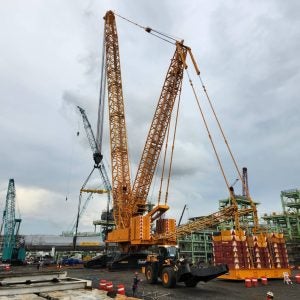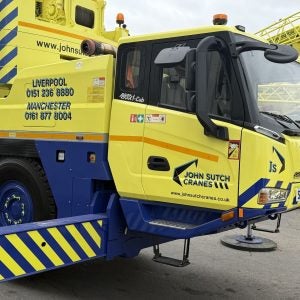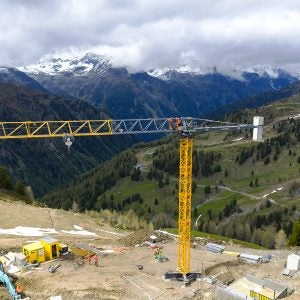
There are two versions of the LCL700 available, with maximum load capacities of 64t and 50t. By means of simple manual modifications, the maximum load capacity of the cranes can be reduced to 32t and 25t respectively, resulting in increased hoist speed and productivity.
This change on the hoist system from double line to single pull line is one of the many improvements that have been implemented into this model based on recommendations from Linden Comansa clients.
The maximum radius of the LCL700 is 65m and can be reduced in increments of 5m to 30m. The LCL700 64t can lift a maximum load of 7.2t at maximum reach, while the LCL700 50t can lift 7.5t. The minimum reach of both models is 4m.
The LCL700 has 'out-of-service' jib radius of between 20.4m and 16m, depending on the maximum reach. The radius of the counter-jib is 9.5m with the potential to be reduced to 8.7m by assembling the crane with steel counterweights rather than the standard concrete counterweights.
The maximum free-standing height of the LCL700 is 69.8m on anchor feet. The LCL700 tower sections, with a 2.5m wide frame, are the same as for the luffing-jib LCL500 model and the flat-top 21LC750.
This new luffing jib crane from Linden Comansa has a 200 kW hoist motor that enables to reach high speeds: up to 134m/min for the LCL700 64t and 170m/min for the LCL700 50t .
The manufacturer said the reason behind this new model was the growing demand for high-tonnage luffers.
Linden Comansa said: “The use of high-tonnage, prefabricated components and extremely large steel beams in construction is a growing trend, based on the fact that it reduces project-completion times. In construction projects involving space constraints, which are becoming increasingly common in the world's largest cities, there is often a need to use large cranes with luffing jibs that enable them to lift extremely heavy loads while avoiding other cranes and nearby buildings.”






